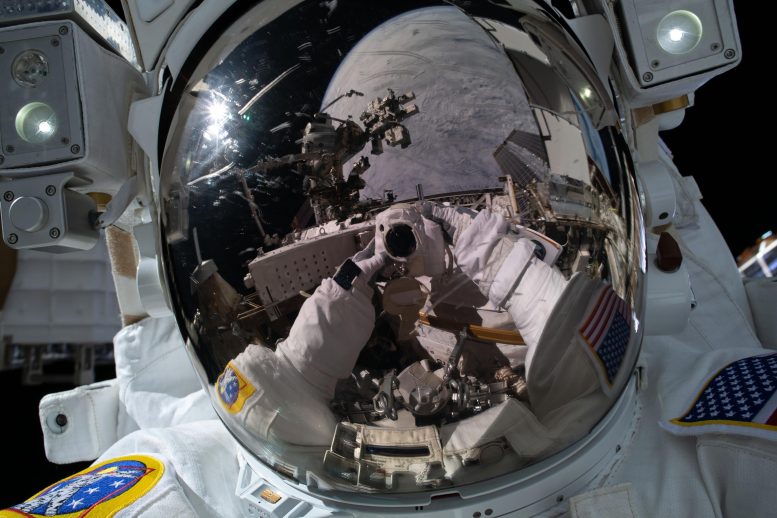
La astronauta Kayla Barron se apunta con la cámara para una inusual «selfie espacial» durante una caminata espacial que tuvo lugar el 2 de diciembre de 2021. Crédito: NASA
La tripulación de la Expedición 66 continuó preparándose hoy para la primera de dos caminatas espaciales que comenzarán la próxima semana para continuar mejorando el sistema de energía de la Estación Espacial Internacional. El jueves también se realizaron escaneos de venas para ayudar a los científicos a comprender cómo la vida en el espacio afecta el cuerpo humano.
Starboard-3 truss structure. The new hardware will enable the upcoming installation of a third roll-out solar array increasing the station’s power output and augmenting the existing solar arrays.
The duo was joined by fellow station astronauts Tom Marshburn of NASA and Matthias Maurer of ESA (European Space Agency) for a spacewalk procedures review and conference with specialists on the ground. Marshburn and Maurer will assist the spacewalkers in and out of their spacesuits, operate the Canadarm2 robotic arm, and monitor their external activities. Mission managers will talk about the spacewalk, as well as a second one planned for March 23, live on the NASA TV app and the website on Monday at 2 p.m. NASA TV begins its live spacewalk broadcast on Tuesday at 6:30 a.m.
The four astronauts also took turns scanning each other’s neck, shoulder and leg veins using the Ultrasound 2 device. Chari and Maurer took turns as the crew medical officer on Thursday afternoon imaging Marshburn’s and Barron’s veins. Doctors on the ground monitored the biomedical activities and will examine downlinked imagery as part of periodic crew health assessments.
NASA Flight Engineer Mark Vande Hei worked throughout the day on maintenance activities servicing research gear and communications hardware. He started the day in the Kibo laboratory module placing combustion science components inside a payload rack then installed a wireless system in the Nauka multipurpose laboratory module.
In the station’s Russian segment, Commander Anton Shkaplerov and Flight Engineer Pyotr Dubrov evaluated an artificial gravity suit that counteracts the pooling of fluids in a crew member’s upper body. The lower body negative pressure suit expands veins and tissues in the lower body possibly preventing vision changes and head pressure in microgravity.

Más historias
Radio Centro: Llega el drástico cambio de WhatsApp en España: las condiciones que deberás aceptar si quieres seguir usando la aplicació
¿Se ha estrellado una pieza de la Estación Espacial Internacional contra una casa en Florida? – Radio Centro
Radio Centro: Conoce Nocturnal Vapor, el nuevo control de Xbox con un diseño enigmático